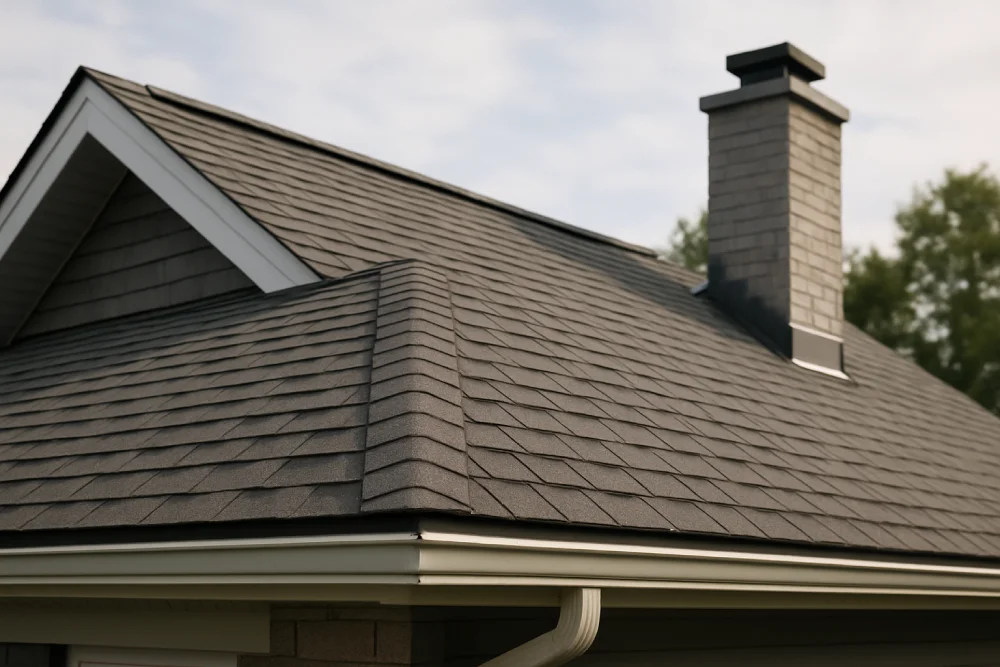
A roof functions as a thorough system that protects and regulates the home while supporting its structure. It efficiently manages environmental forces, using components like decking, weather barriers, and resilient outer layers. The roof prevents moisture intrusion and promotes ventilation, which enhances energy efficiency. Structural elements distribute loads to guarantee stability and longevity. By adhering to regulations and choosing appropriate materials, homeowners can optimize their roof's performance. Ascertain how each aspect contributes to your roof's overall effectiveness.
When considering a roofing system, it is essential to understand its various components, as each plays a pivotal role in ensuring the roof's functionality and longevity. The roof deck materials, typically plywood or OSB, provide the foundational support for all roofing layers. Above this base, multi-layer weather barriers are installed to protect against moisture infiltration. These barriers include underlayment and specialized ice and water shields, acting as indispensable defense mechanisms. The outermost layer, often made of durable shingles or tiles, protects the roof from harsh weather. Proper installation of these components is crucial for achieving quality-first results that enhance the roof's lifespan and performance. Understanding these elements allows homeowners to make informed decisions, ensuring their roofing system effectively safeguards their homes while providing protection from exterior climate.
Structural elements play a key role in the overall integrity and performance of a roofing system, ensuring that the roof can withstand various environmental challenges. Rafters and trusses form the primary framework, distributing loads effectively to external walls. This load distribution consideration is indispensable for maintaining stability and preventing structural failure. Roof decking acts as a sturdy base, supporting both dead and live loads, while supplemental elements like ceiling joists and collar beams enhance strength and prevent deformation. Together, these components contribute to structural performance optimization, allowing roofs to bear weight and resist external forces. Proper installation and maintenance of these structural elements are essential for longevity and effective protection against weather-related damage. Additionally, the use of trusses as triangular structures aids in efficient weight distribution throughout the roofing system. The incorporation of high-performing materials also enhances the roof's durability and energy efficiency, further supporting the home’s overall integrity.
Effective water protection measures are essential for maintaining the longevity and functionality of roofing systems. These strategies not only safeguard the roof but also enhance the overall health of the home. Key methods include:
Ventilation and insulation play a critical role in the overall performance of roofing systems, as they work together to enhance energy efficiency and comfort within the home. Proper ventilation system design expels hot air, which reduces cooling costs and prevents moisture buildup, ensuring optimum insulation levels are maintained. This collaboration not only increases the roof's lifespan by preventing mold and rot but also enhances indoor comfort by stabilizing temperature and humidity. When insulation effectively manages thermal transfer, it reduces energy loss, making heating and cooling systems more efficient. Together, these elements create a balanced system that protects structural integrity while promoting energy savings. Homeowners should prioritize these aspects to achieve a comfortable, energy-efficient living environment.
A roof's regulatory functions are essential for ensuring safety, durability, and performance, complementing the roles of ventilation and insulation in a home's overall efficiency. These functions are governed by building code compliance and regulatory oversight, which serve to protect both the structure and its occupants. Key regulatory aspects include:
Understanding these functions highlights the importance of following regulations for a secure and efficient home.
Maintaining a roof is essential for its longevity. Regular inspections play a pivotal role in this process. Timely repairs can prevent small issues from escalating into costly problems, ensuring the roof remains in good condition. Seasonal maintenance tips, including cleaning gutters and checking for damage, further enhance the roof's durability and overall performance.
While a roof might seem like a simple structure, regular inspections play an indispensable role in guaranteeing its longevity and effectiveness. These assessments are critical for homeowners seeking cost-effective maintenance and proactive problem identification.
Timely repairs are essential for maintaining the integrity and longevity of a roof, as even minor issues can quickly escalate into significant problems. Regular maintenance not only addresses small leaks or damaged shingles but also prevents costly replacements in the future, leading to long term cost savings. High-quality materials and skilled craftsmanship contribute to the durability of these repairs, ensuring they withstand environmental challenges. Additionally, addressing underlying issues, such as water damage, is critical for effective repairs. By prioritizing timely repairs, homeowners can enhance the structural integrity of their homes, which in turn increases home value. A well-maintained roof not only protects the home but also provides peace of mind for the residents living beneath it.
Seasonal maintenance of a roof is essential for guaranteeing its longevity and effectiveness in protecting a home. Regular upkeep helps prevent costly repairs and enhances overall roof performance. Homeowners should consider the following tasks:
Selecting the right roofing materials customized to a specific climate is essential for ensuring the longevity and efficiency of a home. In hot regions, materials like clay and concrete tiles offer excellent thermal resistance and aesthetic appeal, while metal roofing effectively reflects solar radiation. For residential applications in temperate climates, asphalt shingles provide versatility, whereas slate roofs excel in wet regions due to their durability. Homeowners should consider energy efficiency and maintenance needs when choosing materials. Cool roofs, designed to reflect sunlight, enhance indoor comfort and reduce cooling costs. Ultimately, selecting appropriate materials not only addresses climate challenges but also contributes to a home's overall performance and visual appeal, ensuring a lasting investment.
In conclusion, a roof is far more than just a covering; it’s an essential system that protects and enhances the entire home. By understanding its various components—from structural elements to ventilation—homeowners can make well-informed decisions regarding maintenance and materials. When you prioritize these factors, you ensure that your roof operates effectively, delivering reliable protection and comfort for years to come. Investing time and care into your roofing system is a worthwhile endeavor that ultimately supports the overall health and safety of your home.
At TriStar Built, we take pride in our quality-first approach. As a locally owned and insured construction company based in North Texas, we prioritize trust, craftsmanship, and clear communication in every project. With our long-term subcontractor relationships and client-focused service, we’re here to help you maintain a roof that truly supports your home.
Determining roof replacement involves assessing roof age and condition, alongside the established roof maintenance schedule. Signs like curling shingles, visible leaks, or significant wear indicate that replacement may be necessary for continued home protection.
When considering roof overlay, one must evaluate structural integrity and local codes. While roof replacement feasibility can save costs and time, ensuring the existing roof's condition is paramount to avoid future complications.
Signs of a roof leak include visible water stains on ceilings and walls, and damaged shingles that may be missing or curling. These indicators suggest potential moisture intrusion, necessitating prompt inspection and repair to prevent further damage.
Choosing a roofing contractor involves verifying licensing, guaranteeing compliance with local roofing codes, reviewing their portfolio, and assessing customer feedback. Establishing a roof maintenance schedule with a reliable contractor safeguards long-term care and performance.
Costs associated with roof repairs vary significantly, influenced by roofing material prices and unexpected roof repair costs. Factors such as damage severity, roof type, and labor rates also play essential roles in determining overall expenses.

Whether you’re remodeling a home, expanding a business, or starting from the ground up, TriStar Built is here to guide you every step of the way. With a focus on craftsmanship, communication, and results that last, we make the construction process clear, smooth, and worth every investment.

LOCATION: 2126 James Street, Denton, TX 76205
PHONE: (940) 381-2222
© 2025 TRISTAR BUILT - ALL RIGHTS RESERVED | WEB DESIGN & SEO BY: Authority Solutions®